The resolution calls for TxDOT to make the following changes to the project:
- Add east-to-west connections ideally every quarter mile and no less than every half mile along the corridor
- Cover as much of the sunken highway as possible
- Reduce negative impacts on the environment
- Reroute 18-wheeler traffic to SH 130
- Minimize the number of properties that would be demolished during construction
- Add water quality controls to filter runoff from I-35
- Match frontage road speed limits to adjacent neighborhoods
The item—sponsored by District 4 Council Member José “Chito” Vela—passed in a 10-1 vote with only Mayor Kirk Watson dissenting.
“I question the feasibility of demanding TxDOT design the project as dictated by the resolution given that we have yet to identify a funding source for the caps alone,” Watson wrote on a council message board Feb. 20, adding the city likely will not be able to generate the estimated $800 million needed to cap the highway by TxDOT’s fall 2024 deadline.
Watson also added he has concerns with rerouting truck traffic to SH 130 and making changes to the north and south portions of the project, which are well underway.
Meanwhile, dozens of local activists, engineers and traffic experts spoke during public comment, sharing sentiments that the current project would fail to relieve congestion, cause an increase in carbon emissions, and further disconnect residents of East and West Austin.
“We’re being dragged against our will, against the will of our community,” said Joao Paulo Connolly, organizing director for the Austin Justice Coalition, at the meeting. “The community has been united in saying ‘no higher, no wider,’ and we are still here being forced to [swallow this pill no one wants.]”
During the meeting, Vela thanked public commenters for their input while also acknowledging the city’s limited power to change TxDOT’s plan. TxDOT has already awarded contracts and completed the design for the north and south portions of the project, and the central portion—which has received the most community criticism—is expected to break ground in mid-2024.
“We’re going to have to work with TxDOT,” Vela said. “This is a once-in-a-generation opportunity. We’ve got to get it right.”





